Duc’s DIY Intake
Posted by Bare | Last Updated January 20, 2011Information courtesy of Duc
This is a basic walk-through for building your own intake for the VTX 1800. Duc is the original person who came up with this idea, this write-up is based on his idea and expanded with info from my previous write-ups. In Duc’s own words, “If you are mechanically competent this is an easy build”.
I would also like to add – please do not send me emails asking how to cut and drill these pieces. Look at the pics, evaluate the tools at your disposal to do the cutting. If you can’t figure how to do it on your own or don’t have the tools necessary, then perhaps this isn’t the project for you.
Now for my boilerplate disclaimer – undertake this project at your own risk!
If you haven’t done the desmog, let me recommend doing it. Feel free to read that write-up and decide on your own. BUT if you still have the smog setup on the bike, you’ll have to find some way to deal with the PAIR inlet since this project is written for a bike without smog equipment.
Required tools/Materials
- Stock intake – buy one from the forum classifieds or cut up your own
- K&N filter assembly #56-1080
- (Optional) pre-filter for K&N E-3341 filter – use the link above, there are 4 colors available
- K&N crankcase filter #62-1010 or 4 feet of 1/2″ rubber vacuum hose
- Philips screwdriver
- 2 small nuts/bolts/washers for reinstalling the IAT sensor
- Drill and drill bits (various sizes)
- Various metalworking tools, depending on what you have you can use anything from tin snips to a Dremel – evaluate what you need to do and make your own decisions
If you’re removing the stock airbox you’ll also need:
- 5mm allen
- Possibly an impact driver
Look online for the parts you need. Try Googling the filters and buy them from the cheapest seller. The pre-filter is optional if you’re concerned about riding in the rain. However, I’ve never used one when I ride in the rain and I’ve never had a problem. K&N filters are oiled, so they naturally repel some water and a little water in the motor is not going to hurt anything.
Removing the stock airbox
If you are not removing the stock airbox from the bike then you can skip to the next section. If you are removing the stock intake then follow the steps listed here.
Remove the seat and read this article on removing the gas tank. You do not have to remove the gas tank, but you will need to be familiar enough with the process to break the tank loose so you can get the stock airbox off the bike. Remove the dash panel so that you can manipulate the tank, and then slide the tank back about 4″ and lean it over at about a 45 degree angle to left side of frame (it will sit there just fine). If you do not remove the dash panel it will be nearly impossible to maneuver the tank.
Remove the stock airbox cover and filter using the 5mm allen. Then remove the 4 screws that hold on the plastic velocity stacks and the air box “back”. If they stick use an impact driver rather than strip the screws. Just be careful when you hit the driver because you just need a little tap with a hammer and the driver does all the work. Remove the velocity stacks.
If you start to pull the airbox away from the bike, you will see 2 hoses and an electrical plug going to the back of the box, and one small vacuum line plugged into the flapper valve at the top of the airbox (unless you’ve desmogged then you’re missing the PAIR inlet and flapper valve). Reach behind the airbox and pull off all the hoses and the electrical plug. The plug has a little tab that you need to press to get it off. With this removed you should be able to get the airbox off of the bike.
This is a personal decision you’ll need to make before installing the new intake you’re making. The new intake will not have a port to plug the crankcase breather hose into, so you’ll either need a filter like the one I mentioned above (#62-1010) or you can use the 4 feet of vacuum hose to reroute the crank breather under the bike (unfiltered). If you choose to use the K&N crankcase filter, you can install it by slipping the filter nipple through the old lower airbox mounting tab and then attaching the crankcase breather hose. You can see it mounted like this under the new intake in the picture to the right.
If you choose to run without the crankcase filter then take the 4 feet of 1/2″ vacuum hose and replace the existing breather hose. Trace the old hose to the top of the front cylinder (left side), remove the original hose and run the new one from the top of the cylinder down the backbone of the bike and under the seat so it exits under the bike in front of the rear tire. This will be behind the coolant reservoir or your fuel pump depending on what year/model VTX you have. You should be able to see the other (much smaller) overflow vent for the fuel tank in this same area.
Some people will tell you not to do it this way because the crankcase needs filtered air and/or something could possibly clog the line, but to quote Duc:
“I have had mine this way for 50,000+ miles and have done 3 other bikes the same way without a problem. Now I’m not saying you won’t have a problem, but I am saying this is how it was done on bikes for YEARS. If you’re concerned about it then blow air through it when you do a valve adjustment (every 8k miles) for peace of mind.”
At this point you should be able to reinstall the tank, dash, seat, etc by reversing the steps you followed. Installing the new intake can be done without the tank raised.
Making the intake
This is where things get a little more “do-it-yourself”. Duc’s original write-up and pics are a little more basic than what most visitors to my site are used to, so look at the pics below and walk yourself through the process.
Take the K&N filter assembly (#56-1080) and your stock intake “back” and cut/drill them up so you have this:
You’ll have to drill holes in the K&N backing plate for the 4 velocity stack screws to pass through as well as 3 holes for the IAT sensor (sensor and 2 mounting screws). My best advice is to cut a little and test fit, cut a little more and test fit until you have what you need. You can always cut more off but you can’t add if you cut too much.
The black looking “stuff” on the K&N backing plate in the picture is black paint used to prevent rust. The silver looking tape is metal duct tape (like is used for sealing A/C ductwork) used to cover a hole drilled by mistake and two holes that were already in the backing plate. If you don’t have this type of tape, you can use any number of possible solutions for these holes such as JB Weld or silicone sealant. The important thing is to find something that will seal the holes and never come off. This is an area inside the filter element, so if you use something that eventually comes off it will get sucked into your motor – this would be bad!
With everything cut, drilled, sealed, etc install the IAT sensor into the modified K&N backing plate and plug it back into the bike. You’ll need to get 2 small nuts/bolts and possibly washers to mount the IAT sensor to the backing plate.
You’ll be installing everything back onto the throttle body (see pic on left).
Place the K&N backing plate against the throttle body, on top of that place the cut down section of the stock intake, and then secure all that in place using the stock velocity stacks and its 4 Philips screws. Do not reinstall these with the impact driver. Just use a #2 Philips screwdriver.
With all this in place you just need to install the K&N filter element and the top plate and you end up with this finished product (pic below).
That’s it – you’re done – congratulations!
Afterthoughts
This is a GREAT mod designed for those riders who are “do-it-yourselfers.” The overall cost for this project should be between $50 and $100 if you shop around for decent prices on the parts. There is really no difference between this intake and many of the oval aftermarket units that are out there and cost a LOT more. Many riders have done this mod thanks to Duc’s original write-up, and since Duc lost his hosting for it I offered to put it up here. This mod shows that a little thought mixed with planning and elbow-grease can save you a bunch of money on a pretty neat intake.
I don’t have dyno sheets on this intake, but I can tell you that similar oval intakes like the Xtreme Revolutions version and the older CDS model have generally been regarded as some of the better units available for the VTX.
Duc is the original creator of this project and has said he is more than happy to answer emails concerning the process. There are also several pages discussing this project on the VTXOA forums in the 1800 tech section. A little searching there should yield good results.

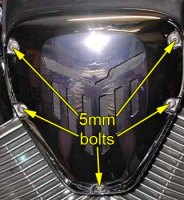
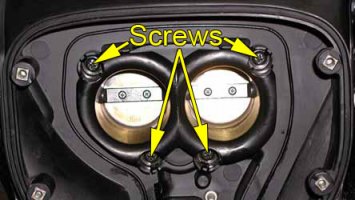
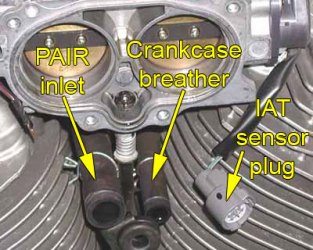
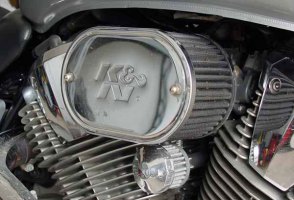
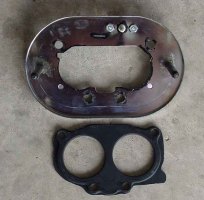
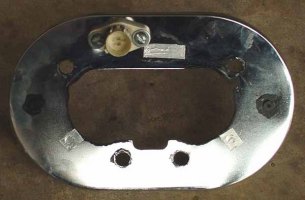
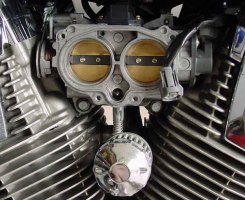
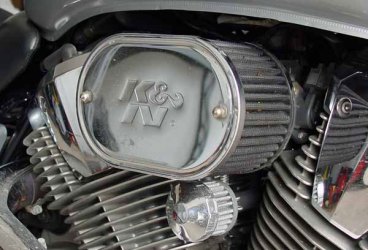
just a question. what do you do with the flapper valve hose? does it just dangle freely? great write up by the way. really appreciate all the time and effort you put into this. thank you.
Used this as a baseline to mount my intake. I used the hyper charger velocity stack instead of oem. And different filter but I just thought I’d let you know that I got my inspiration from this mod. Thanks for all your info on these bikes.